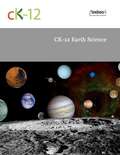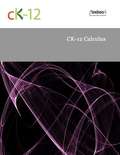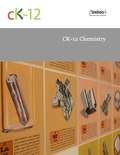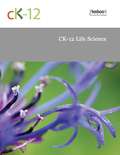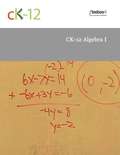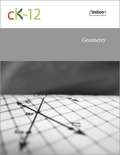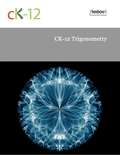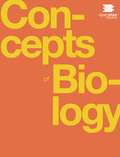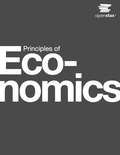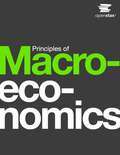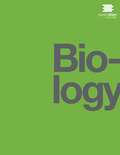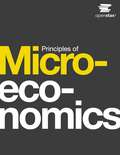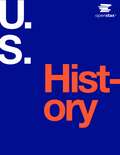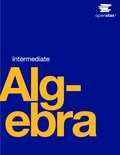Special Collections
Free Upskilling Books for All!
- Table View
- List View
CK-12 Earth Science
by Ck-12 FoundationCK-12 Foundation's Earth Science FlexBook Covers the following chapters: What is Earth Science- scientific method and branches of earth science. Studying Earth's Surface- landforms, map projections and computers/satellites. Earth's Minerals- types, formation, identification , properties and uses. Rocks- rock cycle and types of rocks. Earth's Energy- renewable and nonrenewable resources. Plate Tectonics- Earth's interior, continental drift, seafloor spreading, tectonic movement, plate boundaries, and landforms. Earthquakes- causes, prediction, safety, seismic waves/tsunamis, and rock/mountain building. Volcanoes- formation, landforms and types of magma and eruptions. Weathering and Formation of Soil- mechanical/chemical weathering and soil formation, horizions & climates. Erosion and Deposition- actions of water, wind and gravity. Evidence about the Earth's Past- fossilization and relative/absolute dating. Earth's History- geological time, early history and evolution. Earth's Freshwater- water cycle and lakes, rivers, streams & groundwater. Earth's Oceans- formation, composition, waves/tides, seafloor and ocean life. Earth's Atmosphere- properties, significance, layers, transfer of energy and movement of air. Weather- cloud types, air movement, storms, and forecasting. Climate- factors that affect climate, different climates, and global climate change. Ecosystems and Human Population- role, flow of matter/energy, carbon cycle and effect of human population growth. Human Actions and the Land- erosion and pollution. Human Actions and the Earth's Resources- renewable vs. nonrenewable and conservation & availability. Human Actions and the Earth's Water- usage, distribution, sources, pollution, and protection. Human Action and the Atmosphere- types, causes, effects and reductionObserving and Exploring Space- electromagnetic radiation, telescopes, and current discoveriesEarth, Moon and Sun- properties, motion, tides/eclipses, sun layers and solar activityThe Solar System- motion, formation, inner vs. outer planets, dwarf planets, meteors, asteroids, and comets. Stars, Galaxies and the Universe- constellations, light/energy of stars, classification, evolution, galaxies, dark matter, dark energy, and the Big Bang Theory.
CK-12 Calculus
by Ck-12 FoundationCK-12 Foundation's Single Variable Calculus FlexBook covers the following chapters: Functions, Limits, and Continuity - A review of the basics of functions is given. Students use linear approximations to study the limit process, before a more formal treatment of limits is given. Differentiation - Students explore instantaneous rate of change, and the relationship between continuity and differentiability. The Chain Rule and implicit differentiation are reviewed. Applications of Derivatives - Students gain practice with using the derivatives in related rates problems. Additional topics include The First Derivative Test, The Second Derivative Test, limits at infinity, optimization, and approximation errors. Integration - This chapter includes indefinite integrals calculus, initial value problems, definite integrals, the Fundamental Theorem of Calculus, integration by substitution, and numerical integration. Applications of Integration - This chapter includes applications of the definite integral, such as calculating areas between two curves, volumes, length of curves, and other real-world applications in physics and statistics. Transcendental Functions - This chapter includes differentiation and integration of logarithmic and exponential functions, exponential growth and decay, derivatives and integrals involving inverse trigonometric functions, and L'Hospital's Rule. Integration Techniques - Students explore integration by substitution, integration by parts, integration by partial fractions, trigonometric integrals, trigonometric substitutions, and improper integrals. Infinite Series - This chapter introduces the study of sequences and infinite series. The properties presented describe the behavior of a sequence or series, including whether a sequence approaches a number or an infinite series adds to a number.
CK-12 Chemistry
by Ck-12 FoundationCK-12 Foundation's Chemistry FlexBook Covers the following chapters: The Science of Chemistry- scientific method, history, matter, energy. Chemistry: A Physical Science- measurement, formulas. Chemistry in the Laboratory- qualitative vs. quantitative observation. The Atomic Theory- atomic model from Dalton to Rutherford. The Bohr Model of the Atom- electromagnetic radiation, atomic spectra & Bohr model. Quantum Mechanics Model of the Atom- energy and standing waves, Heisenberg's uncertainty principle, Schrödinger's equation. Electron Configurations for Atoms- electron spin, Aufbau principle. Electron Configurations and the Periodic Table- relation of electron configuration to position on the periodic table. Relationships Between the Elements- chemical families from electron configuration; valence electrons, Lewis dot formulas. Trends on the Periodic Table- periodic trends: atomic size. Ions and the Compounds They Form- ionization, ionic bonding. Writing and Naming Ionic Formulas- predicting charge. Covalent Bonding- nature and naming of covalent bonds. Molecular Architecture- polar molecule, electronic/ molecular models of covalent molecules. Chemical Reactions- mass & mole calculations, reaction types. Mathematics and Chemical Equations- stoichiometry, heat of reaction. The Kinetic Molecular Theory- gas properties, combined and universal gas laws. The Liquid State- phase change. The Solid State- intermolecular forces. Solution Process- solvation, concentration, solubility, colligative properties. Ions in Solution- dissociation, electrolytes, non-electrolytes, ionic/ net-ionic equations. Chemical Kinetics- reaction rate. Chemical Equilibrium- reaction rates, equilibrium constant, Le Chatelier's principle, solubility product constant. Acids and Bases- strength of acids & bases, hydrolysis, pH. Water, pH, and Titration- dissociation of water, acid-base indicators, buffers. Thermodynamics- bond breaking and formation, heat of reaction and formation, Hess' law, entropy, Gibb's free energy. Electrochemistry- oxidation-reduction, electrochemical cells. Nuclear Chemistry- radioactivity, nuclear equations/ energy. Organic Chemistry- hydrocarbons, functional groups.
CK-12 Life Science
by Ck-12 FoundationCK-12 Foundation's Life Science FlexBook Covers the following chapters:Studying Life- Nature of science: scientific method. tools used in science and safety in research. Introduction to Living Organisms- what they are, what they are made of, and classification. Introduces carbs, lipids, proteins, and nucleic acids. Cells and Their Structures- what they are, what they are made of, organelles and eukaryotic vs. prokaryotic. Cell Functions- ctive transport, passive transport, photosynthesis, and cellular respirationCell Division, Reproduction, and DNA- mitosis, meiosis, DNA, RNA, and protein synthesisGenetics- Mendel's peas to gene therapy. Evolution- Darwin's natural selection, history of life and evidence of evolution. Prokaryotes- properties and characteristicsProtists and Fungi- properties, characteristics, reproduction and metabolismPlants- nonvascular & vascular, gymnosperms & amniosperms and hormones/tropismsIntroduction to Invertebrates- sponges, cnidarians, and wormsOther Invertebrates- mollusks, echinoderms, arthropods, and insectsFishes, Amphibians, and Reptiles- fishes, amphibians, and reptilesBirds and Mammals- characteristics, properties, diversity and significanceBehavior of Animals- communication, cooperation, mating and cyclesSkin, Bones, and Muscles- skeletal, muscular and integumentary systemsFood and the Digestive System- nutrition and digestionCardiovascular System- heart, blood, vessels and cardiovascular healthRespiratory and Excratory Systems- breathing and elimination of wasteControlling the Body- Nervous SystemDiseases and the Body's Defenses- Diseases and the immune responseReproductive System and Life Stages- Reproduction, fertilization, development and healthFrom Populations to the Biosphere- Ecology: Communities, ecosystems, biotic vs. abiotic factors, and biomesEcosystem Dynamics- Flow of energy, recyclig of matter, and ecosystem changeEnvironmental Problems- Pollution, renewable vs nonrenewable resources, habitat destruction & extinction, and biodiversity
CK-12 Algebra I
by Ck-12 FoundationCK-12 Foundation's Algebra FlexBook is an introduction to algebraic concepts for the high school student. Topics include: Equations & Functions, Real Numbers, Equations of Lines, Solving Systems of Equations & Quadratic Equations.
CK-12 Geometry
by Ck-12 FoundationCK-12 Foundation's Geometry FlexBook covers the following chapters: Basics of Geometry - undefined terms, defined terms, basic postulates of points, lines and planes; distances on a coordinate grid; complementary and supplementary angles; vertical angles; linear pairs and classification of polygons. Reasoning and Proof - inductive reasoning, deductive reasoning, conditional statements, properties of equality and two-column proofs. Parallel and Perpendicular Lines - the parallel line postulate, the perpendicular line postulate, and angles formed by two parallel lines and a non-perpendicular transversal. Congruent Triangles - the Triangle Sum theorem, triangle congruence, the SSS and ASA postulates, the AAS congruence theorem, two-column and flow proofs, the HL congruence theorem, AAA and SSA relationships, isosceles and equilateral triangles. Relationships Within Triangles - the midsegment theorem, the perpendicular bisector theorem, the angle bisector theorem, the concurrency of medians theorem, Napoleon's theorem, and the triangle inequality theorems. Quadrilaterals - interior angles of convex quadrilaterals, classifying quadrilaterals, properties of parallelograms, properties of rhombi, rectangles and squares, and properties of trapezoids. Similarity - ratio and proportion, properties of similar polygons, AAA and AA rules for similar triangles, using SSS and SAS to solve problems about similar triangles, identifying proportional segments in triangles and similarity transformations. Right Triangle Trigonometry - using the Pythagorean theorem when working with right triangles, classification of triangles, the converse of the Pythagorean theorem, using the geometric mean, properties of special right triangles, and trigonometric ratios. Circles - relationships between congruent and similar circles, the equation of a circle, tangent lines, arc measures, chords, inscribed angles, and angles formed by chords, secants and tangents. Perimeter and Area - finding the area of polygons, using scale drawings or models, finding the circumference of a circle, areas of circles and sectors, calculating the areas and perimeters of regular polygons and geometric probability. Transformations - transformations of figures in two-dimensional space including translations, reflections, rotations and dilations.
CK-12 Trigonometry
by Ck-12 FoundationCK-12 Foundation's Trigonometry FlexBook covers the following chapters: Trigonometry and Right Angles - introduction to the trigonometric functions. Circular Functions - introduction to radian measure, circular functions and periodic functions. Trigonometric Identities - confirm, verify and derive various trigonometric identities. Inverse Functions and Trigonometric Equations - inverse functions to trigonometric functions, and will apply the domain, range and quadrants of the six inverse trigonometric functions to evaluate expressions. Triangles and Vectors - introduction to vectors and vector applications. Polar Equations and Complex Numbers - plot points in a polar coordinate system, graph and recognize limaçons and cardiods, and work with real-world applications involving polar coordinates and polar equations.
Introductory Statistics
by OpenStaxIntroductory Statistics is intended for the one-semester introduction to statistics course for students who are not mathematics or engineering majors. It focuses on the interpretation of statistical results, especially in real world settings, and assumes that students have an understanding of intermediate algebra. In addition to end of section practice and homework sets, examples of each topic are explained step-by-step throughout the text and followed by a Try It problem that is designed as extra practice for students. This book also includes collaborative exercises and statistics labs designed to give students the opportunity to work together and explore key concepts. To support today's student in understanding technology, this book features TI 83, 83+, 84, or 84+ calculator instructions at strategic points throughout. While the book has been built so that each chapter builds on the previous, it can be rearranged to accommodate any instructor's particular needs.
Concepts of Biology
by OpenStaxConcepts of Biology is intended for the introductory biology course for non-science majors taught at most two- and four-year colleges. The scope, sequence, and level of the program are designed to match typical course syllabi. This text includes interesting features that make connections between scientific concepts and the everyday world of students. Concepts of Biology conveys the major themes of biology, such as a foundation in evolution, and features a rich and engaging art program.
Principles of Economics
by OpenStaxPrinciples of Economics covers the scope and sequence for a two-semester principles of economics course. The text also includes many current examples, including; discussions on the great recession, the controversy among economists over the Affordable Care Act (Obamacare), the recent government shutdown, and the appointment of the United States’ first female Federal Reserve chair, Janet Yellen. The pedagogical choices, chapter arrangements, and learning objective fulfillment were developed and vetted with feedback from educators dedicated to the project. The outcome is a balanced approach to micro and macro economics, to both Keynesian and classical views, and to the theory and application of economics concepts. Current events are treated in a politically-balanced way, as well.
Principles of Macroeconomics
by OpenStaxPrinciples of Macroeconomics covers the scope and sequence for a one-semester economics course. The text also includes many current examples, including: the housing bubble and housing crisis, Zimbabwe’s hyperinflation, global unemployment, and the appointment of the United States’ first female Federal Reserve chair, Janet Yellen. The pedagogical choices, chapter arrangements, and learning objective fulfillment were developed and vetted with feedback from educators dedicated to the project. The outcome is a balanced approach to economics, to both Keynesian and classical views, and to the theory and application of economics concepts. Current events are treated in a politically-balanced way, as well.
Biology
by OpenStaxBiology is designed for multi-semester biology courses for science majors. It is grounded on an evolutionary basis and includes exciting features that highlight careers in the biological sciences and everyday applications of the concepts at hand. To meet the needs of today's instructors and students, some content has been strategically condensed while maintaining the overall scope and coverage of traditional texts for this course. Instructors can customize the book, adapting it to the approach that works best in their classroom. Biology also includes an innovative art program that incorporates critical thinking and clicker questions to help students understand--and apply--key concepts.
Principles of Microeconomics
by OpenStaxPrinciples of Microeconomics covers the scope and sequence for a one-semester economics course. The text also includes many current examples, including; the Keystone Pipeline, Occupy Wall Street, and debates over the minimum wage. The pedagogical choices, chapter arrangements, and learning objective fulfillment were developed and vetted with feedback from educators dedicated to the project. The outcome is a balanced approach to economics and to the theory and application of economics concepts. Current events are treated in a politically-balanced way, as well.
Anatomy & Physiology
by OpenStaxHuman Anatomy and Physiology is designed for the two-semester anatomy and physiology course taken by life science and allied health students. The textbook follows the scope and sequence of most Human Anatomy and Physiology courses, and its coverage and organization were informed by hundreds of instructors who teach the course. Instructors can customize the book, adapting it to the approach that works best in their classroom. The artwork for this textbook is aimed focusing student learning through a powerful blend of traditional depictions and instructional innovations. Color is used sparingly, to emphasize the most important aspects of any given illustration. Significant use of micrographs from the University of Michigan complement the illustrations, and provide the students with a meaningful alternate depiction of each concept. Finally, enrichment elements provide relevance and deeper context for students, particularly in the areas of health, disease, and information relevant to their intended careers.
U. S. History
by OpenStaxThis textbook has been created with several goals in mind: accessibility, customization, and student engagement-all while encouraging students toward high levels of academic scholarship. Instructors and students alike will find that this textbook offers a strong foundation in U.S. history in an accessible format. About U.S. History U.S. History has been developed to meet the scope and sequence of most introductory U.S. History courses. At the same time, the book includes a number of innovative features designed to enhance student learning. Instructors can also customize the book, adapting it to the approach that works best in their classroom.
Introduction to Sociology
by OpenStaxIntroduction to Sociology was written by teams of sociology professors and writers and peer-reviewed by college instructors nationwide. The textbook was developed for OpenStax College as part of its Open Educational Resources initiative. This free online text meets standard scope and sequence requirements and incorporates current events such as the Occupy Wall Street movement. The text is designed for the Introduction to Sociology course at any two- to four-year school.
Intermediate Algebra
by OpenStax"Intermediate Algebra is designed to meet the scope and sequence requirements of a one-semester Intermediate algebra course. The book's organization makes it easy to adapt to a variety of course syllabi. The text expands on the fundamental concepts of algebra while addressing the needs of students with diverse backgrounds and learning styles. Each topic builds upon previously developed material to demonstrate the cohesiveness and structure of mathematics."--Open Textbook Library.
College Physics
by OpenStaxThis introductory, algebra-based, two-semester college physics book is grounded with real-world examples, illustrations, and explanations to help students grasp key, fundamental physics concepts. This online, fully editable and customizable title includes learning objectives, concept questions, links to labs and simulations, and ample practice opportunities to solve traditional physics application problems.
Precalculus
by OpenStaxPrecalculus is intended for college-level Precalculus students. Since Precalculus courses vary from one institution to the next, we have attempted to meet the needs of as broad an audience as possible, including all of the content that might be covered in any particular course. The result is a comprehensive book that covers more ground than an instructor could likely cover in a typical one- or two-semester course; but instructors should find, almost without fail, that the topics they wish to include in their syllabus are covered in the text. Many chapters of Openstax Precalculus are suitable for other freshman and sophomore math courses such as College Algebra and Trigonometry; however, instructors of those courses might need to supplement or adjust the material. Openstax will also be releasing a College Algebra and Trigonometry title tailored to the particular scope, sequence, and pedagogy of those courses.
Intermediate Algebra
by OpenStax"Intermediate Algebra is designed to meet the scope and sequence requirements of a one-semester Intermediate algebra course. The book's organization makes it easy to adapt to a variety of course syllabi. The text expands on the fundamental concepts of algebra while addressing the needs of students with diverse backgrounds and learning styles. Each topic builds upon previously developed material to demonstrate the cohesiveness and structure of mathematics."--Open Textbook Library.

